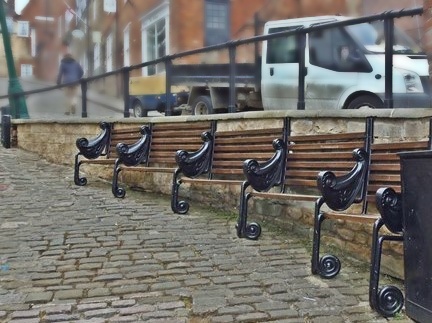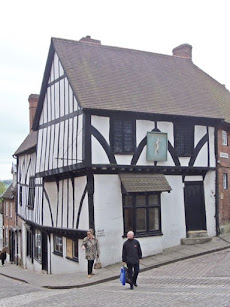Lincoln's Gates
In the medieval age Lincoln had more gates than many other towns or cities of a similar size.
Newport Arch (Porta Principalis Sinistra)
 |
| Newport Arch by Skill |
Built in the 3rd century, Ermine Street passed through it to link Lincoln to another major Roman provincial centre, York. The arch was enlarged when the city became capital of the province Flavie Caesariensis in the 4th century. The remains we see today are of the inner arch and a footway on the east side of the arch, the outer arch was demolished in the late 18th century. The arch was much higher in Roman times, approximately 2.4 metres of it are below today’s ground level. More about the design of the gateway was discovered in 1954 when the north-west bastion, a semi-circular structure, was excavated, the remains of which are still visible. There would have been another bastion on the north-east side of the gateway, the remains of that are now below the adjoining cottage.
 |
| Drawing of Newport Arch dated 1784. The north gate can be seen through the arch. On the right is a sign for the Windmill Inn which dated from 1756 |
The East Gate
The Roman east gate (Porta Praetoria) was re-discovered in about 1730, it had been used as a wall wall between a house and stables. Sadly, it was demolished in 1763 on the orders of Sir Cecil Wray when Eastgate House was extended.
The remains of the Roman East Gate are visible in the grounds of the Lincoln Hotel opposite the north side of the Cathedral Chapter House.
The West Gate
 |
| Roman West Gate uncovered, to the right can be seen the Norman west gate which was reopened in 1993. |
The Roman West Gate of the upper city lies below the west wall of the castle. It was discovered in 1836 when the west side of the Castle Dykings were excavated. It was in almost perfect condition but had to be covered up because the weight of the Norman castle wall was causing it to collapse.
The Exchequer Gate
 |
| Exchequer Gate by Benjamin Howlett 1836 |
The Exchequer Gate, at the west front of the Cathedral, was the main entrance to the Cathedral Close. Built mid 14th century. It was originally a double gate with a courtyard between the gates. The western gate had fallen into disrepair and was pulled down in 1800, the stones were used to build the previous St Swithin's Church, a replacement for the church destroyed by the Royalists during the Civil War, The Great Tom Inn was on the southside of the courtyard, the inn closed in 1822.
The South Gate
 |
| A Drawing of the Roman South Gate by Nathan Drake c 1740 |
The Roman South Gate (Porta Principalis Dextra) stood near the top of Steep Hill. Parts of this gate were still standing in 1788 when Gough visited the city, but the arch was demolished in the early 1700s by a householder on the east side of the gate. According to Thomas Sympson writing in the early 18th century: (the arch was knocked down) "though not without much difficulty, as I have been informed by an eye-witness; for when the workmen, with a great deal of labour and pains, had battered one of the stones in the crown of the arch in pieces, rest being laid without mortar, sunk so equally on both sides that the hung as firm as ever, and their work was to begin anew". The position of the gate is marked by foundation stones on the side of the road
The Old Registry or North Gate of the Close
This double gate stood over the road on the east side of the Cathedral, the south gate on the site of the present Priory Gate the north gate near "The Rest".
Both gates were pulled down in 1815 and the present Priory Gate was built in 1825.
The Bail Gate
On Steep Hill, near the junction with Michaelgate/Wordsworth Street/Christ's Hospital
Terrace stood the Bail Gate, a medieval arch that was demolished in 1775. Separated the Bail
from the city. I can not find an image of the gate but it was probably similar to the Newland Gate
On Steep Hill, near the junction with Michaelgate/Wordsworth Street/Christ's Hospital
Terrace stood the Bail Gate, a medieval arch that was demolished in 1775. Separated the Bail
from the city. I can not find an image of the gate but it was probably similar to the Newland Gate
White Hart Gate
"A gateway near the White Hart Inn, and another opposite are of a workmanship very different from the rest of the erections on the wall of the Close: they possess little beauty and afford still less interest to the beholder. The appearance of that nearest the White Hart, is little superior to that of a country barn; is entirely without battlements, and the upper part projects considerable over the lower, and is supported by props resembling inverted buttresses." - Adam Stark (1815).
Clax le Gate
Clax le Gate or Clask Gate was situated at the junction of what is now Broadgate and Clasketgate. It is said the Knights Templars were confined there click here to read more. It was pulled down in 1785 when New (Later Lindum) Road was constructed.
Stonebow
The name Stonebow is from the Norse Steinbue meaning stone arch
Many streets that run nearby end in -gate which is Norse for street.
The Stonebow lies at the southern end of the Roman city of Lindum Colonia and stands on the site of the southern gate of the lower Roman town spanning Lincoln’s High Street, known as Ermine Street in Roman times. The Roman gateway existed into the mediaeval period but it was demolished in the 14th Century because it was unsafe.
In 1390 Richard II ordered a new gate be built to replace the demolished one. There were many delays in building the new arch, mainly that Lincoln was no longer the prosperous city it once was and could not afford the expense of a new gateway. The Stonebow, was eventually completed by William Spencer, a freeman of the city, in 1520 and is now a Grade 1 listed building.
Newland Gate
Newland Gate stood on Newland a little west of Wigford Way, first recorded in 1275. It was the
west entrance of the lower city. A tall building with gables with a pointed archway, above were
arched windows. The gate was added to during the Civil War to defend the city against the
Parliamentarians. Demolished before 1800 because it was causing congestion in that part
of the city.
Dernstall Lock
Dernstall Lock (sometimes mistakenly referred to as "St Dunstan's Lock") was the lower entrance to the Jews' quarter in mediaeval times. It is not known whether there was a gate, a chain was placed over the road and locked to keep the Jews in there at night. Great Bargate
Great Bargate stood on the High Street a few feet north of the Sincil Drain. It was the main
entrance from the south into Lincoln. Removed in the middle of the 18th century.
Great Bargate stood on the High Street a few feet north of the Sincil Drain. It was the main
entrance from the south into Lincoln. Removed in the middle of the 18th century.
Little Bar Gate
Little Bargate stood east of Great Bar Gate on a bend in the Sincil Drain, it stood over the
route of the Roman Ermine Street. The gate was removed in the middle of the 18th century
and the bridge removed in 1825.
Little Bargate stood east of Great Bar Gate on a bend in the Sincil Drain, it stood over the
route of the Roman Ermine Street. The gate was removed in the middle of the 18th century
and the bridge removed in 1825.
Swine's Gate
Swine's Gate was located south of Great Bar Gate. Here stood the first of the Eleanor Crosses.
Swine's Gate was located south of Great Bar Gate. Here stood the first of the Eleanor Crosses.
















